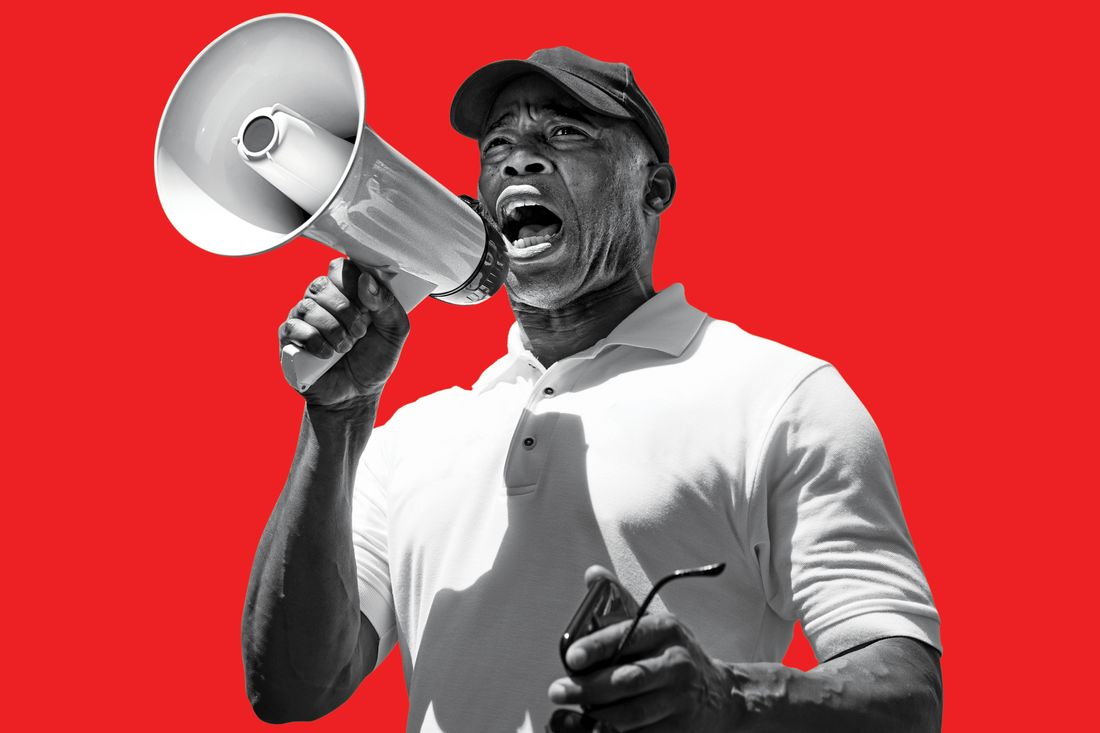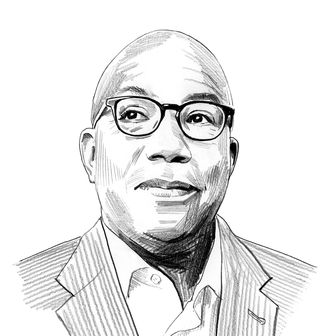
“I’m the mayor” is a phrase Eric Adams says frequently, usually as a way to end an argument against adversaries seen and unseen.
“I don’t know if you’ve been picking up on what’s been happening,” Adams recently told the Brooklyn Chapter of Jack and Jill of America, an organization that supports Black schoolchildren, referring to attempts to limit his control over the Rikers Island jail complex and the city’s schools. “They want to take away everything when Eric becomes the mayor. And I say you’re not getting a darn thing — I’m controlling the city.”
And then the punch line, delivered with a big grin. “One thing they must understand: I’m the mayor.” The crowd of Black middle-class homeowners and professionals — Adams’s political base — cheered.
It’s as if Hizzoner senses a need to make sure his authority is recognized and respected. “People look at your presentation before they take you seriously,” he told a group of graduating college students years ago. “Everything about you must say power.” The question is whether the public believes the mayor’s actions match his rhetoric. The early read is: not really.
A recent NY1–Siena College poll found that 56 percent of New Yorkers thought the city was heading in the wrong direction. The 7 percent who described Adams as doing an excellent job were far outweighed by the
29 percent who called his performance poor.
Only six months into his tenure, Adams finds himself in a deep hole. And he is discovering that, while he may be the mayor of New York, the office is subject to a thick tangle of limits, checks, and balances.
On any given issue, the mayor has to negotiate with the City Council, bargain with municipal unions, comply with court orders, or seek help from state government. Adams, like any New York mayor, is automatically a potent player in the game of municipal power, but he does not necessarily hold the strongest hand. Adams can plead and persuade, bluff and bluster — a little swagger goes a long way — but ultimately he has to win over a wide range of allies and opponents, not all of whom are overly impressed by the fact that he’s the mayor. And he has to convince New Yorkers that his various plans for public safety and the economy are working.
Ed Koch, whom Adams has referred to as a model, famously punched above his weight as mayor. In the early years following the fiscal crisis of the 1970s, Koch used a brash personal style to suggest he was fully in charge of the city, at one point pronouncing himself the “Mayatollah.” In reality, a vast amount of fiscal authority was legally in the hands of the state-run Financial Control Board, which snatched power from City Hall as a condition of staving off New York’s near bankruptcy.
Adams is trying to re-create Koch’s conjuring trick of wielding his personal style like a weapon. But so far the numbers are damning, especially on Adams’s signature issue of public safety. Seventy-six percent of those polled said they are very concerned or somewhat concerned about becoming victims of violent crime, and only 5 percent said the mayor is doing an excellent job on the issue, compared with 45 percent who rated his performance as poor.
The mayor, who spent months insisting that more people needed to join him in recognizing the peril posed by rising street violence, is now blaming the media for creating a false impression of the level of danger in the city. Nick Pinto at the blog Hell Gate noted the about-face: “The mayor’s remarks appeared best read as a thinly veiled swipe at people like Eric Adams, who have sought to portray the subways as dangerous, with remarks like, ‘On day one, I took the subway system, I felt unsafe. I saw homeless everywhere. People were yelling on the trains. There was a feeling of disorder.’ ”
When City Hall eventually gets its messaging straight, the bottom line will likely be that the statistics on the scariest violence — homicides and shootings — have been broadly positive, and that’s a damn good start. Robberies, burglaries, and grand larceny are terrible crimes, but they aren’t the problems that matters most: Gun violence and fatalities are in a different category and have to take priority.
Adams has proposed to double the number of cops patrolling subways, a strategy he calls “omnipresence,” which is intended to make passengers feel safe and discourage criminals from using the system. A special anti-gun unit takes to the streets in select neighborhoods with a focus on building cases against people who hold, sell, and use illegal weapons. (Whether the unit can refrain from the excessive force that has marred the reputation of its predecessors will be another test of its success.) And Adams is supporting community-based violence interrupters who try to informally discourage gang feuds and other sources of gunplay.
A federal judge has given the Department of Correction, which runs Rikers Island, four months to prove it can turn around the rampant violence in city jails before Rikers is possibly placed in a federal receivership. But there is progress, and much of the credit goes to Correction Commissioner Louis Molina. “Slashings and stabbings have been decreasing; in the month of May, they were down 44 percent; calendar year to date, they’re down 21 percent. We’ve done a lot of contraband-weapons seizures, over 2,000 in five months,” he told me. “Our staffing absenteeism is down 40 percent. We’re not where we want to be, but that’s a significant improvement from where we were last summer.”
Reducing violence at Rikers, where many people are staying for only a few days or months while waiting for their day in court, is a vital part of cooling things off in the handful of neighborhoods that have been disproportionately represented in jails for decades.
Reviving New York’s post-pandemic economy might be a tougher task, with Adams ordering city workers back to the office immediately as his central strategy. “It is so critical for New Yorkers to come back to the office. It’s critical because our commercial districts, our office districts, are really the arteries that pump life into our economy, into our tax base,” Maria Torres-Springer, the deputy mayor for economic and workforce development, told me. “It’s not just for the employers. It’s also about the small businesses, the local bodega, the local small business, the local restaurant that lost a lot of their livelihood and revenues during the pandemic.”
That’s easier said than done. Moreover, Adams’s explicit effort to re-create the pre-COVID economy, with lots of office workers in midtown and downtown, augmented by hordes of tourists and business travelers, may be an outdated model. “As of late April 2022, 38 percent of Manhattan office workers are currently at the workplace on an average weekday. Only 8 percent are in the office five days a week,” a recent survey by the Partnership for New York City found. “Remote work is here to stay.”
Other Adams strategies, like streamlining the bureaucratic maze that small businesses must navigate to open new restaurants, seem sensible. But they are too small scale to move the needle in a city that is still more than 200,000 jobs shy of pre-pandemic levels at a time when high inflation and a crumbling stock market suggest we are on the brink of a recession.
Adams, a vocal cheerleader for New York nightlife, is living up to his early promise to be guided by emotional intelligence and focused on making a visceral connection with New Yorkers. But rents are rising along with crime, and it’s not clear whether Adams has the wherewithal to address such concerns. The good news for him is that a majority of the same New Yorkers who are panning his performance say — 53 percent to 37 percent — that they like his style. That means we’re in for a lot more situations where Adams may not have a great solution to city problems, but he’s definitely going to let us know who’s calling the shots.






























